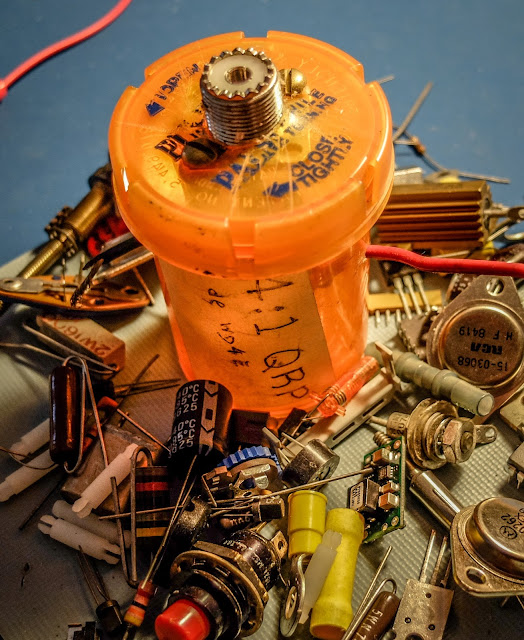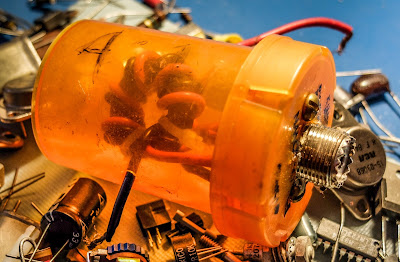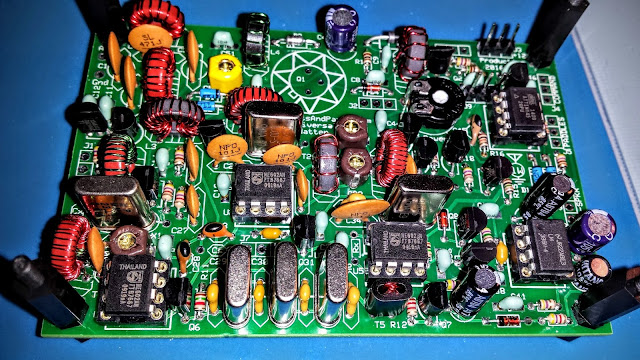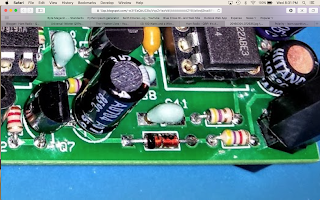Posts Tagged ‘QRPp’
 100mW’s of raw power!!
100mW’s of raw power!!
The other evening I was having a cup of tea and checking out my new QST that just arrived and found myself very interested in a piece written by Steve Ford in his column Eclectic Technology. The title caught my eye "When a signal is barely a WSPR" Steve looked at how the Raspberry Pi could be used for WSPR transmissions. Seeing I have the Raspberry Pi3 this sparked my interest. It was pointed out that all you need to turn your Pi into a WSPR transmitter is a board from TAPR called QRPi. The board is offered at a very reasonable price of 29.00 U.S and it's set for 20m at 100mW. Before I got to excited about this little project I wanted to see if using 100mW's would net me any results. I have seen other hams in the past net great results with far less than 100mW's and WSPR is known for it's great decode at very low power........BUT.......I do have a challenging setup here. On Friday late afternoon I gave WSPR a go on 20m at 100mW and was I impressed with the results. I was received by DK6UG for a distance of 39383 miles per watt and also ON7KO for a distance of 37285 miles per watt. I was amazed that my setup was able to produce those results! Now another question I wanted to consider is at 100mW how much of that actual power makes it to my antenna? To do this I referred to a coax calculator I punched in the type of coax (RG8X) the SWR (1.4:1) the length (30 feet) the frequency (14) and finally the power (100mW) The calculated amount I was informed was 92mW of raw power! So this bumped my miles per watt to 42810 for DK6UG and 4053 for ON7KO! It's not timo look more into the TAPR project!!
 Just the medicine for lowering impedance
Just the medicine for lowering impedance
Pill bottle balun
Jack-WD4E is a fellow NAQCC member and he sent me one of his QRP creations that I just had to share.
If you are staying on your meds you probably have the perfect enclosure for a QRP Balun.
 |
| If I could save RF in a bottle... |
Jack encloses his home-brew wound toroids in pill bottles.
The child and arthritis proof cap keeps the goods away from young and old alike...
Just what the doctor prescribed...
So re-purpose your medicare paid goodness and put it to work for you
Sorry all you entrepreneurs, Jack told me that he's already applied for the patent so you won't be competing with Facebook with this product idea. He owns it.
That's all for now
So lower your power and raise your expectations
72/73
 It’s ALIVE !
It’s ALIVE !
The 1Watter 40m #551 -- Lives
 |
| The 1Watter 40m on it's inaugural QSO |
 |
| Inside the enclosure |
The 1Watter is a kit from kits and parts dot com
The Universal 1Watter (also called the 1H2O) is a full featured little superhet radio transceiver that you can build for about $50. It doesn't come with an enclosure, a tuning pot, speed pot or an on/off switch so that will cost extra unless you already have some in the junk bin.
Some of the features include;
- 1 mighty watt of output
- Good selectivity from the 3 crystal filters
- A VCXO tuned frequency range for the 40m band from approximately 7,020 kHz through 7,039 kHz
- A built-in full functioned keyer with provision for adding a speed pot and messages
- Included command button accesses the functions of the electronic keyer
- Natural sounding sidetone (nicer than my Ten-Tec Century/21)
The Build
The kit is delivered in a box and inside are a couple of brown paper bags stapled together. Inside one of the bags are a couple of plastic bags with the components. The other bag contained the header kit. The ferrite toroid mix types are separated in different unmarked plastic bags so don't mix them up (the instructions tell you which bag has each mix). If anything is missing the kit supplier (Diz, W8DIZ) is very responsive.
The kit includes both SMT caps and through hole caps. I tried to solder one of the SMTs but I didn't have the right kind of tweezers to hold it in position for soldering so I used the through hole caps.
 |
| SMT and through hole caps are supplied |
This is the 3rd revision of the Universal 1Watter board and I was the first to build the 40m version.
While the schematic was correct, some of the instructions weren't sorted out properly for the 40m kit. I related issues as I found them to the designer and he promptly updated the online documentation.
I soldered the components and wound toroids as I had time over a few evenings and the initial voltage tests went well.
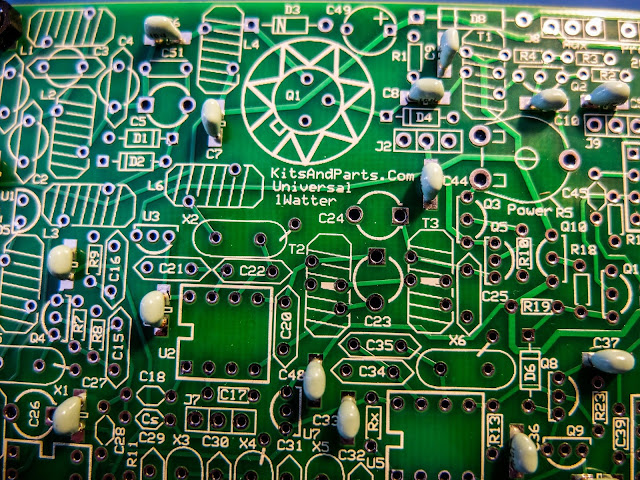 |
| using through hole capacitors rather than the SMTs |
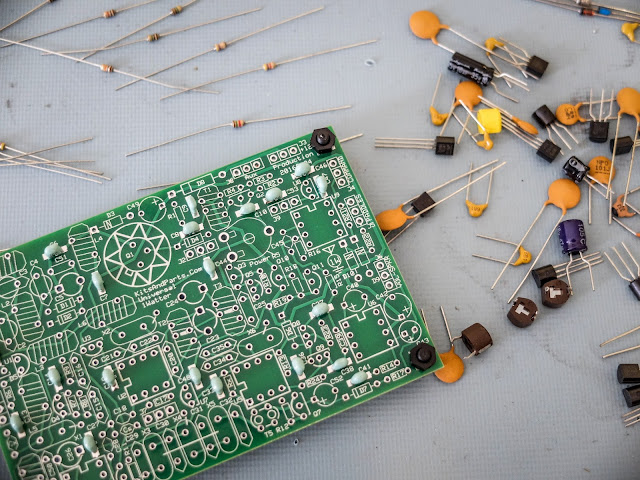 |
| some of the bits and bobs |
 |
| build is progressing |
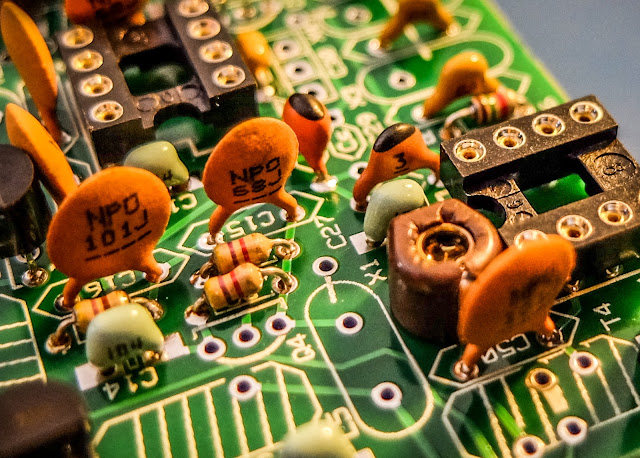 |
| close up |
Debugging
When the build was completed I connected the rig to an antenna and heard nothing.
The keying circuit and transmitter worked fine and I verified those functions but the receiver was deaf as a stump.
Thus began a number of days of investigation. Diz (the creator of the board) guided me through a number of debugging steps.
The first recommendation was to examine and rewind the binocular toroid balun that transformed the impedance from the xtal filters to the input of the U5 oscillator. He believed that I may had wound it incorrectly. I desoldered it and rewound it but that did not resolve the issue.
He then guided me through determining if one of the filter crystals or filter capacitors was bad. I desoldered a few components as a tests but that did not resolve the issue.
There are 3 identical mixer chips on the board. I swapped them around as there was a suggestion that there were some faulty chips in one of Diz's shipments.
I then took the board to my Elmer Paul Stroud AA4XX. He had a signal generator, Oscilloscope and RF detector. He traced the RF and all looked well but we still were unable to obtain any signal through the U5 mixer. Lastly we tried disconnecting the AGC transistor to see if it was clamping it and that didn't resolve it either.
Diz asked me to return the radio to him so he could take a look. After a couple weeks he emailed me saying he thought the BFO xtal might have a problem. But he later discovered that the oscillator in U5 was not starting up. Apparently the circuit design had a low Q and needed more current to get the oscillator working. He modified the design, adding a 16k resistor to the bottom of the board on U5 to get the oscillator going. After that all was well and he shipped the board back to me.
Learning from problems
Being the first person to build a particular version of a kit brings its own set of challenges, especially when you're as new to kit building debugging RF problems as I am. However I'm actually glad the kit didn't work right at the initial build.The process of debugging the board, was a great learning process. I studied the schematics and learned, as best I could, the function of each circuit so that I could better understand how to test it. During the debugging process Diz instructed me that although RF signal generators and scopes are useful you can tell a lot by touching a RF component with an inductive metal object and listening for a buzz or hum from the BFO.
So all-in-all, even though the bug in the board was not due to a error on my part, I'm glad it occurred. I understand more about superhet radio design than I did before and more than if the kit had worked right off the bat.
On the air
After receiving the board back, I hooked up the frequency XCO potentiometer, paddle, command button, audio and output potentiometer and an external speaker. I then connected a 12v battery and heard the 1H2O keyer chip announce itself at power up in Morse "1 W".
 |
| Frequency control pot on the left |
 |
| Volume control, output jack, cmd pot and paddle input |
For this first on-air excursion I was using it at the default startup 15wpm keyer speed. You can default the speed higher with a different resistor value.
I have a resistor shrink wrapped and connected in-line to the blue-white wire coiling above the radio connecting to the speed pot terminal. In essence fixing the speed at 15wpm until I add the speed pot.
 |
| Ready to transmit |
 |
| On the air... I was using my paddle out of the photo to the right of the Bug |
First On Air QSO
I tuned around and found a strong station at the end of a QSO near 7030 kHz.
When he sent the final dit-dit I called and WD4AXJ answered my first call. He was in TN near Knoxville, and I received a 559. We chatted for about 10 minutes. Sorry about the blurry video. I thought I'd focused.
After I recorded this video I found an open frequency and sent out my call. Very shortly thereafter KD2FSH answered my call and reported me as 599!
Whoo - hoo. 599 for my little 1Watter 40m.
I was transmitting using my 40m attic antenna. So deed restricted HAMs take note. You can build a one-watt radio and make contacts using your attic antenna. Haha.
You'll hear in the video there is some weirdness going on with the audio derived AGC. It is clamping down sometimes and is worse when I don't have the volume turned up very loud. When I began calling it clamped after every semi-break-in but didn't do it much after that. I'll have to look into that.
The AGC clamping may be a side effect of the increased gain Diz added to the BFO oscillator. I'll ask the forum.
Other than the AGC issue I'm super pleased with the little board. I touched the heat sync a couple of times after transmitting my side of the qso and it was warm but not really hot. It seems as though as long as you have a reasonable match to the antenna the power transistor should be happy.
My next steps are to get it in an enclosure and get it out to the Excalibur antenna site to hook onto that nice 40m doublet we put up a couple weekends ago. I plan to use my efficient little BLT tuner for that purpose. I will do a further review of the feature set on the keyer and record some more qsos for a later review.
Summary
The band was fairly busy and the little 1Watter did a fine job with stations on nearby frequencies. You can hear some getting around the passband but it is not bad at all. I'll do some tests to further define it's selectivity but at first glance it is far better than my old Ten-Tec Century/21.
My calls were answered quickly and I received good signal reports. It didn't sound as though the transmitter was drifting at all during the QSO. That's one advantage of using VCXO in the design. The disadvantage of using a crystal controlled oscillator for the frequency control is limited tuning range. The transmitter only has about a 18 kHz tuning range around 7030 kHz and I don't find many of the SKCC folks around that frequency but it is the QRP watering hole for 40m.
It is possible to shift the frequency with some capacitance changes but I think I'll leave it as is for a time and see how many states I can work.
Just imagine. This little $50 single band kit has good selectivity, a nice built-in keyer with a natural sounding sidetone, and lest we forget... You get a MIGHTY 1 WATT of OUTPUT. What more could a QRP ham need.
That one-watt of output was sufficient for all the QSOs I attempted tonight.
So lower your power and raise your expectations
72/73
Richard, AA4OO
UPDATE: 04/01/2016
I am still having the AGC pumping issue and others on the list have reported similar issues but only on receive. It happens to me when I key unless I turn up the volume very high. I did get it installed in a case but I still need to wire up a real power connector rather than using alligator clips.
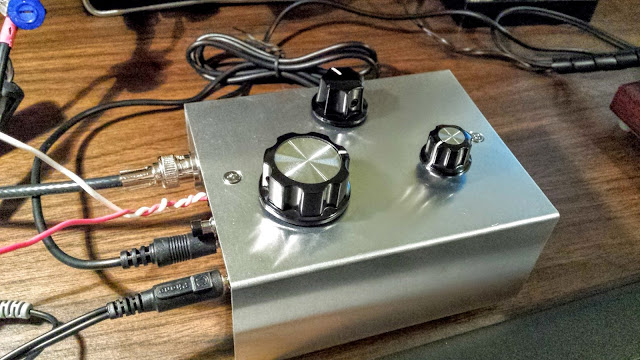 |
| !Watter installed in a case |
UPDATE: 04/05/2016
After doing quite a bit of reading I learned that the LM386 op-amp used in the 1watter is rather notorious for audio oscillations. There are a number of suggested fixes. I went with a 4.7uf cap connecting Pin 7 on U6 (the LM386) to ground. That hasn't totally resolved the issue but it's much less pronounced now.
I have it in the case with all the proper plugs now (see below) so I'm happy. I've been making QSOs every day with it and it continues to amaze me and the stations that work me. It is stable as a rock with regard to frequency and the large knob with the single turn 10k pot seems to work well for tuning. I have enough control to vary the frequency slightly without having to turn it too much. The tuning range is only about 20kHz so just 3 frequency markers are plenty to let me know what frequency I'm near. The selectivity is just fantastic for such a simple little radio. Diz has created an inexpensive winner.
 |
| cap fix for LM386 oscillations |
 |
| 1Watter in enclosure with all the proper connectors for the case |
 I got to be the Flea on the Hound last night
I got to be the Flea on the Hound last night
Last evening's QRP Fox hunt was of the 80 Meter flavor. Our esteemed Foxes were Brian K0DTJ in California and Dave N1IX in New Hampshire. "Conventional Wisdom" told me that I'd probably have a good shot at working Dave in NH, but probably not so much for Brian in CA.
This time, Conventional Wisdom did not disappoint.
I worked Dave pretty quickly. According to my log, I nabbed him at 0203 UTC. And as I suspected, Brian was nowhere to be heard. Actually, Brian and his pack of Hounds were nowhere to be heard, except for an occasional "Woof" and "Arf" from a Hound here and there.
I ended up spending the evening listening to Dave handle his pileup. It was a treat as N1IX is an accomplished Amateur Radio Op, to say the least. He handled all calls rapidly and without error. He also QRS'ed (slowed his code speed for those of you not familiar with the Q Code) from time to time when it was warranted. Dave is a member of the A-1 Operators Club, which is no surprise, and his inclusion is well deserved.
Towards the end of the hunt, Dave had fewer and fewer Hounds baying at him, and as a result, he was calling "CQ FOX" quite a lot. QUITE a lot. And, at the same time, his signal strength to me was actually increasing.
So at 0311 UTC, I decided to do something that I've never done before. I dialed the KX3's power output down to the flea power neighborhood - 100 milliWatts (that's 1/10th of 1 Watt for those of you, who like me, sometimes scratch your head when it comes to scientific notation), and gave Dave another call. In the past, I've only called a Fox a second time if I wasn't positive about being in the log, and I've certainly have never done it QRPp.
Thanks to Dave's excellent ears and superb station, I made it into "Official" log at 0311 at 100 milliWatts of power. According to QRZ, Dave lives 233 miles from me as the proverbial crow flies. So that means the QSO was accomplished last night as a rate of 2330 Miles per Watt.
Not too shabby, and you just GOTTA love this QRP stuff!
72 de Larry W2LJ
QRP - When you care to send the very least!
This time, Conventional Wisdom did not disappoint.
I worked Dave pretty quickly. According to my log, I nabbed him at 0203 UTC. And as I suspected, Brian was nowhere to be heard. Actually, Brian and his pack of Hounds were nowhere to be heard, except for an occasional "Woof" and "Arf" from a Hound here and there.
I ended up spending the evening listening to Dave handle his pileup. It was a treat as N1IX is an accomplished Amateur Radio Op, to say the least. He handled all calls rapidly and without error. He also QRS'ed (slowed his code speed for those of you not familiar with the Q Code) from time to time when it was warranted. Dave is a member of the A-1 Operators Club, which is no surprise, and his inclusion is well deserved.
Towards the end of the hunt, Dave had fewer and fewer Hounds baying at him, and as a result, he was calling "CQ FOX" quite a lot. QUITE a lot. And, at the same time, his signal strength to me was actually increasing.
So at 0311 UTC, I decided to do something that I've never done before. I dialed the KX3's power output down to the flea power neighborhood - 100 milliWatts (that's 1/10th of 1 Watt for those of you, who like me, sometimes scratch your head when it comes to scientific notation), and gave Dave another call. In the past, I've only called a Fox a second time if I wasn't positive about being in the log, and I've certainly have never done it QRPp.
Thanks to Dave's excellent ears and superb station, I made it into "Official" log at 0311 at 100 milliWatts of power. According to QRZ, Dave lives 233 miles from me as the proverbial crow flies. So that means the QSO was accomplished last night as a rate of 2330 Miles per Watt.
Not too shabby, and you just GOTTA love this QRP stuff!
72 de Larry W2LJ
QRP - When you care to send the very least!
 I got to be the Flea on the Hound last night
I got to be the Flea on the Hound last night
Last evening's QRP Fox hunt was of the 80 Meter flavor. Our esteemed Foxes were Brian K0DTJ in California and Dave N1IX in New Hampshire. "Conventional Wisdom" told me that I'd probably have a good shot at working Dave in NH, but probably not so much for Brian in CA.
This time, Conventional Wisdom did not disappoint.
I worked Dave pretty quickly. According to my log, I nabbed him at 0203 UTC. And as I suspected, Brian was nowhere to be heard. Actually, Brian and his pack of Hounds were nowhere to be heard, except for an occasional "Woof" and "Arf" from a Hound here and there.
I ended up spending the evening listening to Dave handle his pileup. It was a treat as N1IX is an accomplished Amateur Radio Op, to say the least. He handled all calls rapidly and without error. He also QRS'ed (slowed his code speed for those of you not familiar with the Q Code) from time to time when it was warranted. Dave is a member of the A-1 Operators Club, which is no surprise, and his inclusion is well deserved.
Towards the end of the hunt, Dave had fewer and fewer Hounds baying at him, and as a result, he was calling "CQ FOX" quite a lot. QUITE a lot. And, at the same time, his signal strength to me was actually increasing.
So at 0311 UTC, I decided to do something that I've never done before. I dialed the KX3's power output down to the flea power neighborhood - 100 milliWatts (that's 1/10th of 1 Watt for those of you, who like me, sometimes scratch your head when it comes to scientific notation), and gave Dave another call. In the past, I've only called a Fox a second time if I wasn't positive about being in the log, and I've certainly have never done it QRPp.
Thanks to Dave's excellent ears and superb station, I made it into "Official" log at 0311 at 100 milliWatts of power. According to QRZ, Dave lives 233 miles from me as the proverbial crow flies. So that means the QSO was accomplished last night as a rate of 2330 Miles per Watt.
Not too shabby, and you just GOTTA love this QRP stuff!
72 de Larry W2LJ
QRP - When you care to send the very least!
This time, Conventional Wisdom did not disappoint.
I worked Dave pretty quickly. According to my log, I nabbed him at 0203 UTC. And as I suspected, Brian was nowhere to be heard. Actually, Brian and his pack of Hounds were nowhere to be heard, except for an occasional "Woof" and "Arf" from a Hound here and there.
I ended up spending the evening listening to Dave handle his pileup. It was a treat as N1IX is an accomplished Amateur Radio Op, to say the least. He handled all calls rapidly and without error. He also QRS'ed (slowed his code speed for those of you not familiar with the Q Code) from time to time when it was warranted. Dave is a member of the A-1 Operators Club, which is no surprise, and his inclusion is well deserved.
Towards the end of the hunt, Dave had fewer and fewer Hounds baying at him, and as a result, he was calling "CQ FOX" quite a lot. QUITE a lot. And, at the same time, his signal strength to me was actually increasing.
So at 0311 UTC, I decided to do something that I've never done before. I dialed the KX3's power output down to the flea power neighborhood - 100 milliWatts (that's 1/10th of 1 Watt for those of you, who like me, sometimes scratch your head when it comes to scientific notation), and gave Dave another call. In the past, I've only called a Fox a second time if I wasn't positive about being in the log, and I've certainly have never done it QRPp.
Thanks to Dave's excellent ears and superb station, I made it into "Official" log at 0311 at 100 milliWatts of power. According to QRZ, Dave lives 233 miles from me as the proverbial crow flies. So that means the QSO was accomplished last night as a rate of 2330 Miles per Watt.
Not too shabby, and you just GOTTA love this QRP stuff!
72 de Larry W2LJ
QRP - When you care to send the very least!
 1 Watt and a Wire… in the Attic
1 Watt and a Wire… in the Attic
You can't always get what you want, but you try sometimes...
Recently I've dialed my normal 5 watts down to 1watt (one watt, singular) for all my contacts. To throw some water on the fire I've decided to use my attic antenna which weaves all around my metal ductwork and electrical wiring. Mostly this was to prove a point to myself but it may be enlightening to deed restricted hams that they can use a qrp radio and an attic antenna successfully.
 |
| Key lineup... Palm Single (paddle), Vibroplex Bug (circa 1970s), Kent Hand key |
It only seems pointless until you try
Calling CQ with 1w QRPp into a poor attic antenna isn't as pointless as it would seem. I didn't have to wait long when calling CQ before I got an answer most of the time.
Now am I going to bust a pileup with 1 watt ? Possibly not but I think that my assumptions about both how much power I need and how big an antenna I need are usually out of proportion with reality.
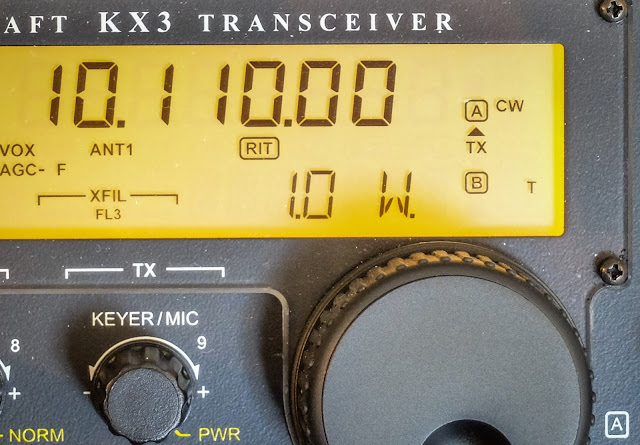 |
| 1 mighty watt |
My assumptions are often incorrect
I made QSOs on 30m, 20m, 17m and 10m this morning all at 1 watt. The solar conditions report was not really fantastic, especially for 10m. Yet 1 watt through the attic antenna bagged the only DX I heard on 10m. I had a couple of other multiple exchange contacts on 20m, 17m and one good old fashioned 25 minute long ragchew on 30m where I received a 599 report for my one watt from Bob (NR8M) in Ohio. Admittedly, Bob was booming in and we had good propagation to each other.
 |
| http://www.hamqsl.com/solar.html |
Video
The recording below was number 4 or 5 this morning. I wanted to post this one because I was working another QRP station in Arkansas (K5EDM) and we did NOT have great propagation to each other. He was running 5w while I was running 1w so it was QRP to QRPp. In the video you can see that I'm using some of the KX3's tricks to pull the signal up because there was a lot of QSB and noise (note the GEOMAGNETIC FIELD UNSETTLED in the solar report).
I had the volume maxed and was using the RF gain control mostly. I eventually had to turn on the preamp which really washed me in noise but I dropped the RF gain more and eventually switched in the APF (audio peaking filter) which performed magic on this contact. Often I find that APF doesn't help but this time it made a big difference.
That's all for now
So lower your power and raise your expectations
72/73
Richard N4PBQ
 VE3WDM is back into QRPp very low power contacts!
VE3WDM is back into QRPp very low power contacts!
I was feeling under the weather this weekend and thought it would be nice and relaxing to spend some time on the radio. It so happens a CW contest was in full swing the Russian DX contest. I was not into competing but just handing out points. The propagation conditions this past week were a struggle to say the least. Today the conditions were on the rebound a K index of 2 and the Sunspots were in at 27 and the solar wind was still up at 615. I parked on 15m and there was lots of DX rolling in for the contest. I made only 7 contacts for Saturday (so far) most were done with QRPp power! I was very pleased that my condo antenna was able to get out to make some great QRPp low power contacts. My K3 is only able to get down as low at 100mW's silly me I sold my attenuator thinking my contacts under 100mW's were over! I was able to make 3 contacts at milli watt power, 2 contacts at 1 watt, one contact at 3 watts and finally 5 watts. My first QRPp contact in the contest was K5WA in the states, my next QRPp contact was with EA3CX in Spain. Then finally F5IN in France with 500mW's of power.
The 7 contacts break down as follows
1. F5IN 500mW 7,500 miles per watt
2. K5WA 100mW 13,213 miles per watt
3. EA5CX 100mW 39,956 miles per watt
4. DK3QZ 1 watt 3,818 miles per watt
5. DL0AO 1 watt 3,818 miles per watt
6. HC2SL 3 watts
7. ZF2DX 5 watts
